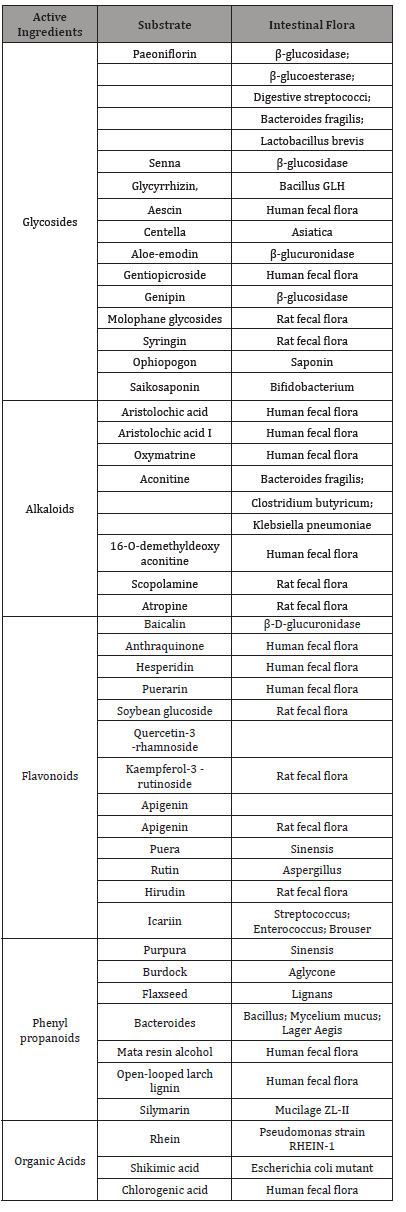Authored by Yufeng Liu*,
Introduction
Traditional Chinese Medicine (TCM) is of great significance to the research and development of new drugs due to its various active components. Meanwhile, as the focus of current research, biotransformation greatly stimulates the investigation of TCM. Intestine is the primary place for the metabolism of oral drugs in the human body, where a number of parasite bacteria flora play an inevitable role in the biotransformation of drugs. Thus, it is obviously that the biotransformation based on intestinal flora is a powerful tool in the development of TCM.
There are four situations after the oral administration of TCM: first, the original formation of active ingredients of TCM is absorbed and exert their pharmacological effects; second, the metabolites of original active ingredients, which transformed by intestinal bacteria, are absorbed by human body and then generate the pharmaco logical effects; third, the active ingredients of TCM in the intestinal tract regulate the environmental balance of intestinal flora; last, TCM is excreted with feces. Obviously, the second situation should be stressed in the biotransformation of TCM.
In recent years, the biotransformation of TCM in intestinal bacteria mainly focuses on the investigation of the metabolism of its active ingredients including Glycosides, Alkaloids, Flavonoids, Phenylpropanoid and Organic Acids, etc. The transformation of these compounds in intestinal flora often results in various consequences, such as the increasing of bioavailability, the improvement of pharmacological effect and the reduction of toxicity [1]. Therefore, the biotransformation of intestinal bacteria is a necessary method for the functional mechanism of Chinese medicine. All of the studies related to the investigation of the biotransformation of the active ingredients are listed in Table 1.
Table 1:Research of biotransformation on different active ingredients in Chinese medicine.

Glycosides often have various pharmacological effects, such as antibacterial, antiviral, anti-inflammatory antiepileptic and so on [2]. However, they are not easily absorbed in the intestine due to the glycosyl in their structure. Moreover, the low bioavailability decreases the pharmacological activities. Fortunately, recent pharmacokinetic studies have proved that the glycosyl of most glycosides can be removed and transformed to the aglycone via the metabolism of the intestinal flora [3,4]. Taking paeoniflorin as an example, the active ingredient of paeoniflorin is a bicyclic monoterpene glycoside compound so that is hard to be absorbed directly. After catalyzed by β-glucosidase, its metabolites can exert antiepileptic and anticonvulsant effects [5].
Alkaloids are a class of nitrogen-containing organic compounds that have good pharmacological activities in terms of immune function, antibacterial, antiinflammatory, and anticancer effects [6]. Some alkaloids may have toxic side effects, such as diester aconitine, which shows a high toxicity. However, the molecule is easily dehydrated and hydrolyzed by the intestinal flora, which metabolites such as monoester type and lipid alkaloids to reduce toxicity [7,8].
Flavonoids is kind of polyphenolic compounds which widely present in plants. Most of flavonoids are in the form of glycosides while others exist in free form [9]. According to recent studies, most flavonoids in the gastrointestinal tract can convert into phenolic acid via the intestinal flora and then absorbed by the human body. For example, Liu et al. [10] used in-vitro cultivated intestinal bacteria to transform baicalin and found that β-D-glucuronidase existed in bacteria could convert baicalin into baicalein, which has antibacterial, antiinflammatory and other effects.
Phenylpropanoids generally contain a lactone structure, mainly including phenylpropionic acid, coumarin, and lignans. The transformation of intestinal flora can induce the hydrolysis or demethylation of the lactone structure of Phenylpropanoids. Therefore, we could suppose that the biotransformation of intestinal flora might be benefit to the structural modification of drugs.
Organic acids refer to a group of acidic compounds containing a carboxyl in their molecular structure. Most TCMs with sour taste contain such components. Organic acids have a wide range of pharmacological effects, such as antiinflammatory, analgesic, antiviral, antituberculosis, inhibition of platelet aggregation and induction of tumor cell apoptosis. A large number of studies have shown that chlorogenic acid is metabolized by the intestinal bacteria after oral administration and gained pharmacological activity [11].
To summarize, the biotransformation of the intestinal flora is an inseparable part of the metabolism of drugs in the human body and can be actively applied to the research and development of TCM. This technique can greatly accelerate the process of the modernization of Traditional Chinese Medicine, such as the studying of metabolism mechanism, the optimization of the structure, the decreasing of the toxicity, the improving of the absorption and so on. Therefore, it is of great practical significance to promote the research and development of TCM.
To read more about this article...Open access Journal of Pharmacy & Pharmacology Research
Please follow the URL to access more information about this article
To know more about our Journals...Iris Publishers





No comments:
Post a Comment